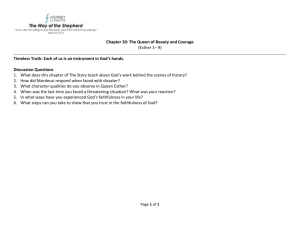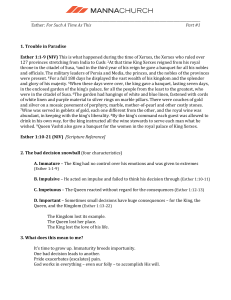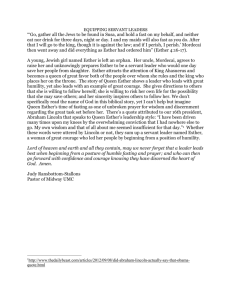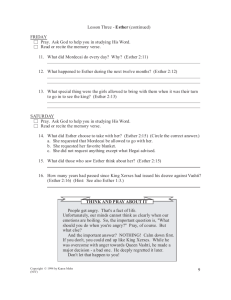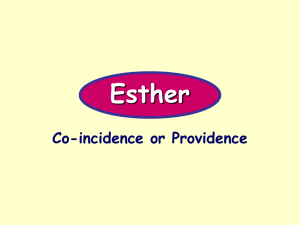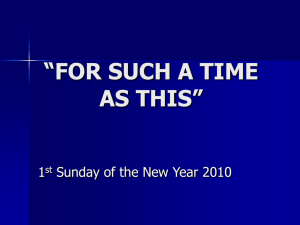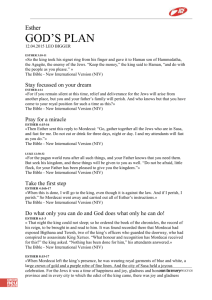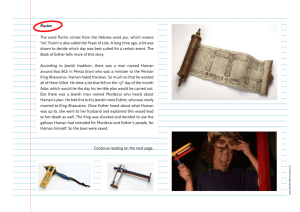Introduction to Esther
advertisement
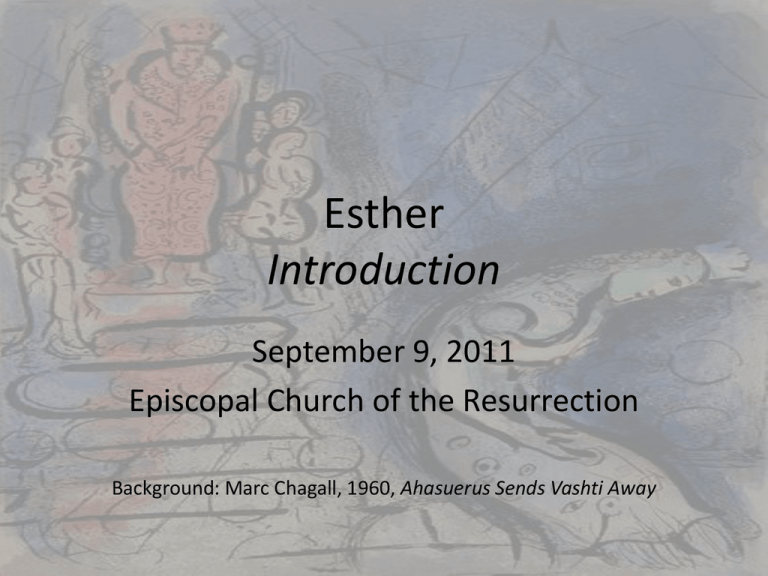
Esther Introduction September 9, 2011 Episcopal Church of the Resurrection Background: Marc Chagall, 1960, Ahasuerus Sends Vashti Away Overview of Esther • On the surface: – Read like a romance novel: young and beautiful heroine, wicked and scheming villain, wise father-figure, comical ruler, good triumphs over evil, everyone lives happily ever after • Beneath the surface: – Racism, genocide, pride, vanity, justice • Purpose? – “An entertaining story written for an oppressed minority that ties what was probably originally a pagan holiday into a Jewish context.” Perceptions of Esther • “No other book in the Hebrew Bible has received such mixed reviews from Jews and Christians alike.” • Martin Luther: – “I am so hostile to this book that I wish it did not exist, for it Judaizes too much, and has too much heathen naughtiness.” • Not till 3rd Century AD did Jews recognize it as canonical • Very popular among regular people. Not popular among religious officials Popular with the People, Criticized by Theologians • No mention of God, prayer, temple, religious activity • Esther marries a gentile, eats non-kosher, assimilates among Persians • Jewish is ethnic, not religious identity • Additions try to change this • But, God seems to be operating behind the scenes –feels modern in this sense Author • Unknown • May have been Persian Jew living in Diaspora trying to live full Jewish life • This could account for neglect of traditional Jewish themes as it tries to establish Diaspora tradition of Purim • Writer demonstrates knowledge of Persian court • Women sometimes represented marginalization of Diaspora Jews who had to accommodate alien environment • Likely the author used some existing blocks or narrative to create a single story, writing by single author Audience • “The audience the book addresses appears to be Jews who live in close proximity to foreign rulers and must learn to make their own way in a society in which they are a minority and in which there is always danger of persecution and oppression.” – Women’s Bible Commentary, 131 • Audience may have been more ethnically than religiously Jewish Genre • Esther is not history. It is a novella, set within a historical framework – Xerxes’ queen was Amestris, not Vashti • No stylistic traits of oral tradition. It was written • Purpose: demonstrate retributive justice, need for oppressed people to be bold and shrewd • Includes satire, irony, farce and tragedy • Story has symmetrical reversal of fate for the villain and hero, so it reads like a morality tale • Jewish Bible places Esther in the “Writings” alongside Psalms, wisdom books and late literature like Daniel, Chronicles, Ezra and Nehemiah The Setting • Set in royal court of Sura in the Persian empire during the reign of Xerxes I, 486-465 B.C. • Takes place within Jewish Diaspora during exile Very Rough Outline of Jewish History • • • • • • • • • • • • • • • • • • • • 1800s-1600s BC? – Time of Patriarchs 1400s BC? – Israelites in Egypt 1300s BC? – Moses and Exodus 1200s BC? – Conquest of Canaan 877-836 BC? – King David 825 BC? – First temple completed 796 BC – Israel splits into two kingdoms 722 BC – Assyrians conquer northern Israel 612 BC – Babylonians defeat Assyrians 486-465 BC – Reign of Xerxes I, setting for Esther 422 BC – Babylonians Conquer Israel, destroy temple Late 4th/Early 3rd Century BC – Esther likely written 370 BC – Jews return from Babylonian exile 312 BC – Greeks conquer Israel Late 3rd Century BC – Greek version of Esther lengthened by 107 verses 167 BC – Maccabean revolt begins 63 BC – Romans invade Israel 37 BC – Herod the Great begins rule 67 AD – Jews revolt against Rome 70 AD – Romans sack Jerusalem, destroy temple Placing Esther • Must have been written after Xerxes’ reign: 486-465 BC • Author unfamiliar with particulars of Xerxes, so it might be distant from Xerxes’ time • Lacks Greek influence and language, so it was likely written before 312 • Generally positive towards Gentiles and foreign rulers, unlike later books • Probably written in Persia, since it has no interest in Jerusalem or the Temple • Shows knowledge of Persian court customs that would have been unfamiliar in Israel Relationship to OT • Persian king is mentioned 190 times. God is mentioned 0 times • No mention of basic Jewish themes like: law, covenant, prayer, diet, Jerusalem • Composition resembeles Daniel and Judith • Allusions to Joseph story, Exodus, conquest, Saul and Naboth • Quotes eremiah, Zephaniah, Isaiah, Zechariah • Includes maxims from proverbs • Many parallels to Daniel –Jewish hero surviving by wits among gentiles Women in the Bible • Only two books in the Bible, Esther and Ruth, are named for women • Many women in the Bible go un-named • Women treated as property, forced into marriage, used as concubines • Purity laws biased against women • Women had little power outside of home • Women did tremendous amount of labor • Most (though not all) divine imagery is male • Esther was powerless in her context because she was a female Jew, yet used manipulation to save her people Sex and Violence • Esther, the hero, is a concubine who marries a non-Jew to become queen. This violated Jewish ethics on several fronts • Mordecai has over 75,000 people killed when he takes his revenge on the persians • Haman’s children are all executed Purim • Probably originated as Babylonian or Persian holiday adapted by Diaspora Jews • Lesser holiday than those proscribed by Torah • Esther is read in aloud. At mention of Haman, kids rattle noise-makers and boo • Orthodox Jews often get very drunk – Tradition says one should drink until he can no longer distinguish the phrases "Cursed is Haman” and "Blessed is Mordecai” • Customary to send food gifts to friends, give to charity and eat a festive meal • Often people put on costumes in celebration an to commemorate God “disguising” his presence behind events • Purim spiel is a comical dramatization of the story with music and dancing and far-ranging stories • Celebrated on 14th day of Adar – Usually in March Additions to Esther • Written for Greek speaking Jews in 2nd or 1st Century BC • Much of the translation is faithful to the original Hebrew version, but six additional sections were added • Additions contradict the Hebrew often • Goal is to transform the book into a conventional tale of divine intervention and exceptional Jewish piety • “God” and “Lord” are used more than 50 times in the additions and inserted into original text Additions to Esther • Addition A: Mordecai’s dream and discovery of plot against king • Addition B: Royal edict by Haman decreeing extermination of Jews • Addition C: Prayers of Mordecai and Esther • Addition D: Esther appears unsummoned before king • Addition E: Royal edict dictated by Mordecai countering Haman’s decree • Addition F: Interpretation of Mordecai’s dream Schedule • September 8 – Introduction • September 15 – Esther 1:1-2:4, Parties, Politics and Power – Esther 2:5-3:15, Personnel, Programs – and Pogroms • September 22 – Esther 5:9-6:14, Plots, Parades and Providence – Esther 7:1-8:17, Counterplots and Counter-Edicts • September 29 – Esther 9:1-10:3, Dueling Decrees and Purim Parties – Additions to Esther

